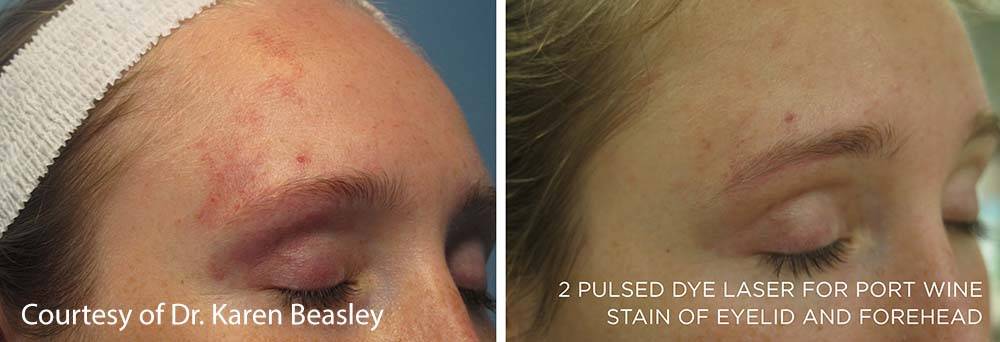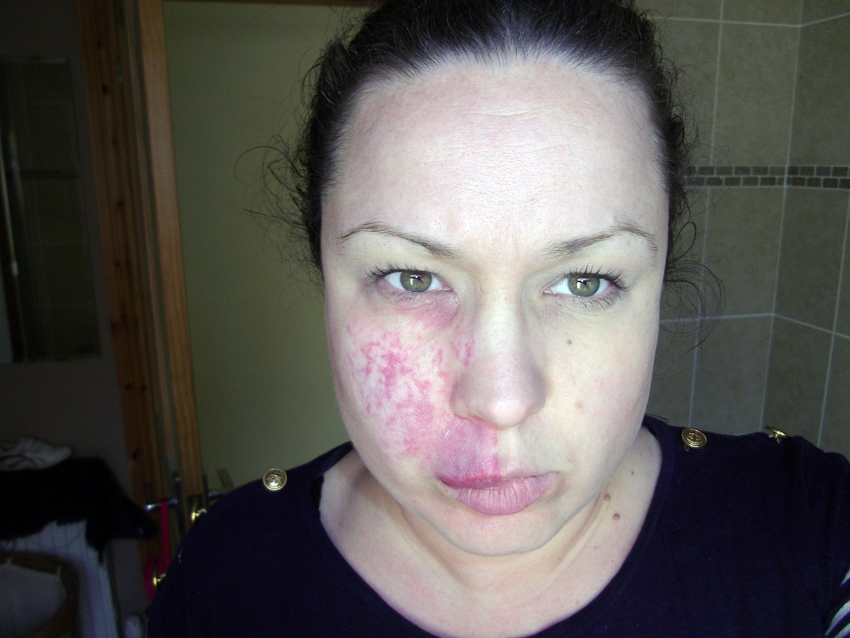
Facial PWSs often occur in the region of the first and second trigeminal nerves. At birth, PWSs are typically flat, sharply delineated, light-red lesions, often occupying large surface areas. PORT-WINE STAINS (PWSs)-a congenital, progressive ectasia of the superficial cutaneous vascular plexus-appear in 0.3% to 0.5% of newborns. No scarring was observed.Ĭonclusion Intense pulsed light source presents an effective and safe method for treating PWSs, especially purple PWSs. Transient pigmentation changes were seen in 10.8% of patients (hypopigmentation in 3, hyperpigmentation in 1 ).

Side effects included purpura in 133 (76%), superficial blisters in 14 (8%), and crusting in 35 (20%). Parameters used most frequently were 515- and 550-nm cutoff filters, pulse duration of 2.5 to 5.0 milliseconds, and fluences of 24 to 60 J/cm 2.

The average number of sessions for purple PWSs reaching good clearance (70%-99%) was 4.2 sessions. The average number of treatment sessions in PWSs reaching 100% clearance included 4.0 for pink PWSs and 1.5 for red PWSs. Results Good and complete (70%-100%) clearance was achieved in 28 of 40 PWSs treated with IPLS. Main Outcome Measures Data collected included treatment parameter (filters, pulse duration, fluence, and pulse sequencing), percentage of clearance, and side effects (purpura, blisters, crusting, altered pigmentation, and scarring). Interventions All patients were treated with IPLS. Clinical PWS characteristics recorded were color and location of the PWS. Patients A total of 37 randomly selected patients with a total of 40 PWSs were included in the study. Setting The data were collected by physicians working in private practices and departments of university hospitals and medical centers, respectively. Objective We investigated whether a noncoherent intense pulsed light source (IPLS) would be effective in therapy of port-wine stains (PWSs).ĭesign To evaluate the efficacy in treatment of PWSs with IPLS, a retrospective study was initiated. Shared Decision Making and Communication.Scientific Discovery and the Future of Medicine.Health Care Economics, Insurance, Payment.Clinical Implications of Basic Neuroscience.Challenges in Clinical Electrocardiography.

Pulsed Dye Laser (Candela Vbeam Perfecta).įor more information, please visit our library.Ĭlick here for a printable patient handout. Thickened, red/purple or burgundy colored papules over the Port-Wine Stain which may bleed red/purple facial stain may be associated with seizures, glaucoma, and intellectual and developmental disabilities (Sturge Weber Syndrome). See our incredible patient Before and After images here. A birthmark can be checked during a medical visit and we can let you know if there could be any concern for complications ahead and what treatment options are available. Our care is customized and we guide our patients every step of the way. Our team has set the “Gold Standard” of treatment for birthmarks with advanced approaches to managing them. We have been treating PWS and various birthmark types for over 30 years. PWS do not go away by themselves and will thicken, darken and lead to deformity without treatment. Unlike Hemangiomas, Port-Wine Stains grow proportionately as the child grows.
#PORT WINE STAINS TREATMENT SKIN#
The red or burgundy patch on the skin slowly darkens and thickens in the first several decades of life, which may develop localized thickenings (blebs) that can bleed or become infected. The PWS was named so because the skin appears as though a red, pink or purple liquid, such as port wine, has been poured over it. PWS is a pink to purple birthmark composed of an abnormal collection of dilated blood vessels present beneath the skin.

Port-Wine Stain (PWS) occurs in an estimated 3 children per 1,000 live births.


 0 kommentar(er)
0 kommentar(er)
